- Department of Plant and Environmental Sciences, Faculty of Science, University of Copenhagen, Taastrup, Denmark
A Corrigendum on
Side-effects of laser weeding: quantifying off-target risks to earthworms (Enchytraeids) and insects (Tenebrio molitor and Adalia bipunctata)
by Andreasen C, Vlassi E, Johannsen KS and Jensen SM (2023). Front. Agron. 5:1198840. doi: 10.3389/fagro.2023.1198840
In the published article, the dosages were calculated incorrectly. We have therefore made a number of corrections to the text.
In the Abstract, the sentence “In all earthworms experiments except one, the mortality rates of the worms living in the uppermost soil layer of clay, sandy, and organic soil exposed to laser heating were not significantly different from the controls even with laser dosages up to 236 J mm-2.” should read “In all earthworms experiments except one, the mortality rates of the worms living in the uppermost soil layer of clay, sandy, and organic soil exposed to laser heating were not significantly different from the controls even with laser dosages up to 23.8 J mm-2.”
In the Introduction, paragraph 8, the sentences “A laser energy dose of 236 J mm-2 may be used to control seedlings of weeds in agricultural and horticultural fields. Weed plants on the cotyledons and two permanent leaf stages are usually killed when they are exposed to 157 J mm-2 (Heisel et al., 2002; Andreasen et al., 2022). We also exposed larvae, pupae, and beetles of T. molitor and the A. bipunctata beetle to increasing doses of laser energy. We hypothesized that all organisms would be negatively affected if they were exposed to an energy level of 79−236 J mm-2) which may be used to control dicotyledon and monocotyledon weeds at the early stages of development (Coleman et al., 2021; Andreasen et al., 2022).” should read “A laser energy dose of 15 J mm-2 may be used to control seedlings of weeds in agricultural and horticultural fields. Weed plants on the cotyledons and two permanent leaf stages are usually killed when they are exposed to 10 J mm-2 (Heisel et al., 2002; Andreasen et al., 2022). We also exposed larvae, pupae, and beetles of T. molitor and the A. bipunctata beetle to increasing doses of laser energy. We hypothesized that all organisms would be negatively affected if they were exposed to an energy level of 8–24 J mm-2) which may be used to control dicotyledon and monocotyledon weeds at the early stages of development (Coleman et al., 2021; Andreasen et al., 2022).”
In Section 2.1, paragraph 2, the sentence “The target organisms were placed approximately 40 cm below the laser head and exposed to increasing dosages of laser energy (from 0 to 235.71 J mm-2)” should read “The target organisms were placed approximately 40 cm below the laser head and exposed to increasing dosages of laser energy (from 0 to 23.9 J mm-2).”
In Section 2.2.2, paragraph 2, the sentences “After the soil was placed in the tubes three worms were transfer to each tube and kept for one day in a climate cabinet in darkness at 20°C ± 2°C before laser treatment. For each soil type and laser doses (0 (control), 0.5, 1, and 1.5 seconds corresponding to 0, 78.6, 157.1, and 235.7 J m-2), 10 tubes with three E. albidus worms and 10 tubes with three E. crypticus worms were used.” should read “After the soil was placed in the tubes three worms were transferred to each tube and kept for one day in a climate cabinet in darkness at 20°C ± 2°C before laser treatment. For each soil type and laser dose (0 (control), 0.5, 1, and 1.5 seconds corresponding to 0, 8.0, 15.9, and 23.9 J m-2), 10 tubes with three E. albidus worms and 10 tubes with three E. crypticus worms were used.”
In Section 2.3, paragraph 2, the sentence “Ten individuals each of larvae, pupae, and adult T. molitor were exposed to the laser beam for 0, 1, 10, 20, 50, 131 100, and 500 ms corresponding 0, 0.15, 1.57, 3.14, 7.86, 15.71, and 78.57 J mm-2.” should read “Ten individuals each of larvae, pupae, and adult T. molitor were exposed to the laser beam for 0, 1, 10, 20, 50, 100, and 500 ms corresponding to 0, 0.016, 0.16, 0.32, 0.80, 1.59, and 7.95 J mm-2.”
In Section 2.4, paragraph 2, the sentence “The laser dosages were 0, 1, 10, 20, 50, 100, and 500 ms corresponding to 0, 0.15, 1.57, 3.14, 7.86, 15.71, and 78,57 J mm-2.” should read “The laser dosages were 0, 1, 10, 20, 50, 100, and 500 ms corresponding to 0, 0.016, 0.16, 0.32, 0.80, 1.59, and 7.95 J mm-2.”
In Section 3.1, the sentences “Consequently, the NOAEL was the highest dose of 235.71 J mm-2 and the LOAEL could not be estimated. For E. crypticus, the highest laser dose of 235.71 J mm-2 was the only dose significantly higher than the control (p=0.0185), and accordingly the LOAEL, making 157.14 J mm-2 the NOEAL (Supplementary Table 1).” should read “Consequently, the NOAEL was the highest dose of 23.9 J mm-2 and the LOAEL could not be estimated. For E. crypticus, the highest laser dose of 23.9 J mm-2 was the only dose significantly higher than the control (p=0.0185), and accordingly the LOAEL, making 15.9 J mm-2 the NOEAL (Supplementary Table 1).”
In Section 3.2.1, paragraph 2, the sentences “At the smallest dose (0.16 J mm-2) some larvae and pupae developed normally, but some developed into beetles with wing deformities. When the dose was increased to 3.14 J mm-2, most of the insects (all stages) were living, but the living larvae received a spot burn from the laser treatment while living adults had deformed wings. The dead insects became brown, dark or with a big dark spot from the laser. The living larvae developed into deformed beetles that almost immediately died. At a dose of 7.86 J mm-2, more than half of the larvae died.” should read “At the smallest dose (0.016 J mm-2) some larvae and pupae developed normally, but some developed into beetles with wing deformities. When the dose was increased to 0.32 J mm-2, most of the insects (all stages) were living, but the living larvae received a spot burn from the laser treatment while living adults had deformed wings. The dead insects became brown, dark or with a big dark spot from the laser. The living larvae developed into deformed beetles that almost immediately died. At a dose of 0.80 J mm-2, more than half of the larvae died.”
In Section 3.2.1, paragraph 3, the sentences “Very few larvae survived a dose of 15.71 J mm-2. Most larvae died having a dark dehydrated and burned appearance. At a dose of 78.57 J mm-2, almost all the larvae died the first week after application at larva stage.” should read “Very few larvae survived a dose of 1.59 J mm-2. Most larvae died having a dark dehydrated and burned appearance. At a dose of 7.95 J mm-2, almost all the larvae died the first week after application at larva stage.”
In Section 3.2.2, the sentences “When a dose of 0.16 J mm-2 was applied, all pupae developed into beetles with the same survival rate as the control group. However, one third developed deformed wings and/or body (Figure 5B). When the dose was increased to 1.57 J mm-2, the survival rate declined approximately 68%. The living pupae all developed into adults, which, however, had some wing and body deformities. Most of the non-living pupae and beetles were discoloured and broke into small pieces (Figure 5C). When the dose was doubled (3.14 J mm-2), the survival rate decreased even more, and the mortality rate rose to 62%. The appearance of non-living adults varied from injured (Figure 5D), cut into pieces or dead bodies without any indication of abnormal appearance. A dose of 7.85 J mm-2 increased the mortality to approximately 85%. Many pupae did not develop into adults as a high number of dead pupae had a brown dark color or completely dark and dehydrated body. A dose of 15.71 J mm-2 almost killed all insects after 15 days (mortality ~ 97.5%). Many pupae did not develop into adults due to high mortality. Dead pupae had a brown dark color or a completely dark and dehydrated body. At the highest dose (78.57 J mm-2), all pupae died within the first week after the irradiation with a burned-like appearance (Figure 5E).” should read “When a dose of 0.016 J mm-2 was applied, all pupae developed into beetles with the same survival rate as the control group. However, one third developed deformed wings and/or body (Figure 5B). When the dose was increased to 0.16 J mm-2, the survival rate declined approximately 68%. The living pupae all developed into adults, which, however, had some wing and body deformities. Most of the non-living pupae and beetles were discoloured and broke into small pieces (Figure 5C). When the dose was doubled (0.32 J mm-2), the survival rate decreased even more, and the mortality rate rose to 62%. The appearance of non-living adults varied from injured (Figure 5D), cut into pieces or dead bodies without any indication of abnormal appearance. A dose of 0.80 J mm-2 increased the mortality to approximately 85%. Many pupae did not develop into adults as a high number of dead pupae had a brown dark color or completely dark and dehydrated body. A dose of 1.59 J mm-2 almost killed all insects after 15 days (mortality ~ 97.5%). Many pupae did not develop into adults due to high mortality. Dead pupae had a brown dark color or a completely dark and dehydrated body. At the highest dose (7.95 J mm-2), all pupae died within the first week after the irradiation with a burned-like appearance (Figure 5E).”
In Section 3.2.3, the sentences “At the lowest dose (0.15 J mm-2), the mortality did not differentiate from the controls (Figures 6, 7A and Supplementary Table 4). Treatment with 1.57 J mm-2 increased mortality. After applying a dose of 3.14 J mm-2, the mortality rate increased to ca 2.5%.Most of the living adults had a spot derived fromthe laser beam while most of the non-living adults had a small hole from the laser (Figure 7B). More than half of the adults died at a dose of 7.86 J mm-2 with a hole from the laser.” should read “At the lowest dose (0.016 J mm-2), the mortality did not differentiate from the controls (Figures 6, 7A and Supplementary Table 4). Treatment with 0.16 J mm-2 increased mortality. After applying a dose of 0.32 J mm-2, the mortality rate increased to ca 2.5%. Most of the living adults had a spot derived fromthe laser beam while most of the non-living adults had a small hole from the laser (Figure 7B). More than half of the adults died at a dose of 0.80 J mm-2 with a hole from the laser.”
In Section 3.3, the sentences “Even 0.15 J mm-2 affected the shape of the dose-response curve, and the beetle’s elytron became brownish in color (Figure 9). A dose of 7.86 J mm-2 severely harmed the beetles, and almost all beetles died during the 15 days. A dose of 78.57 J mm-2 immediately killed all beetles burning significant holes in the beetles (Figure 9).” should read “Even 0.016 J mm-2 affected the shape of the dose-response curve, and the beetle’s elytron became brownish in color (Figure 9). A dose of 0.80 J mm-2 severely harmed the beetles, and almost all beetles died during the 15 days. A dose of 7.95 J mm-2 immediately killed all beetles burning significant holes in the beetles (Figure 9).”
In Section 4.1, the sentences “There were no differences in mortality between the control group and worms exposed to all laser doses, with a single exception with E. crypticus in sandy soil at a dose of 157 J mm-2. The spread of the heat in the soil from the laser beam depends on the water content and soil structure and composition. We cannot exclude that other conditions like a higher water content or other soil types would result in other mortalities. We consider a soil water content of 50% of the water capacity to be realistic in the early spring when weed control usually is conducted, but it depends on many factors in the field (e.g., variation in soil composition, precipitation, and evaporation). The earthworms in the tubes were living in a very small soil volume (<15 g) during the experiment mimicking the uppermost part of the soil profile. Although heat corresponding to 235,7 J mm-2 was executed on a spot with a 2 mm diameter, which easily kills weed seedling, the exposure did not warm up the soil sufficiently to affect the mortality of the worms living close to the soil surface within the seven days.” should read “There were no differences in mortality between the control group and worms exposed to all laser doses, with a single exception with E. crypticus in sandy soil at a dose of 15.9 J mm-2. The spread of the heat in the soil from the laser beam depends on the water content and soil structure and composition. We cannot exclude that other conditions like a higher water content or other soil types would result in other mortalities. We consider a soil water content of 50% of the water capacity to be realistic in the early spring when weed control usually is conducted, but it depends on many factors in the field (e.g., variation in soil composition, precipitation, and evaporation). The earthworms in the tubes were living in a very small soil volume (<15 g) during the experiment mimicking the uppermost part of the soil profile. Although heat corresponding to 23.9 J mm-2 was executed on a spot with a 2 mm diameter, which easily kills weed seedling, the exposure did not warm up the soil sufficiently to affect the mortality of the worms living close to the soil surface within the seven days.”
In Section 4.2, the sentence “In general, the insects were all killed immediately at a laser dose corresponding to what would be appropriate for killing small weed seedlings (78.57−157.14 J mm-2).” should read “In general, the insects were all killed immediately at a laser dose corresponding to what would be appropriate for killing small weed seedlings (50 J mm-2).”
In Section 5, the sentence “The earthworms were mostly unharmed when the soil surface was exposed to laser dosages up to 236 J mm-2 as the soil protected them.” should read “The earthworms were mostly unharmed when the soil surface was exposed to laser dosages up to 23.9 J mm-2 as the soil protected them.”
The dosages given in Figure 2, Figure 4, Figure 6 and Figure 8 were also incorrect. The corrected figures appear below.
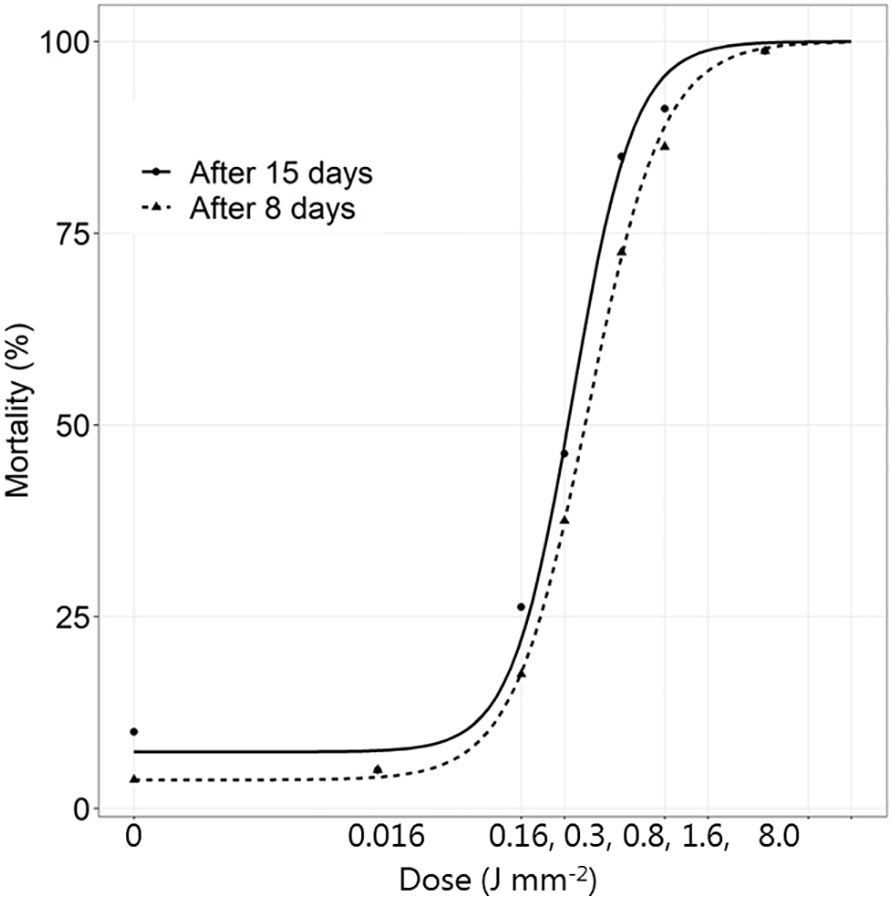
Figure 2 The mortality (%) of Tenebrio molitor larvae 8 and 15 days after exposure to increasing dosages of laser energy (J) from a thulium-doped 2 μm 50 W fiber laser with a collimated beam with a diameter of 2 mm. Points show mean values (n=20).
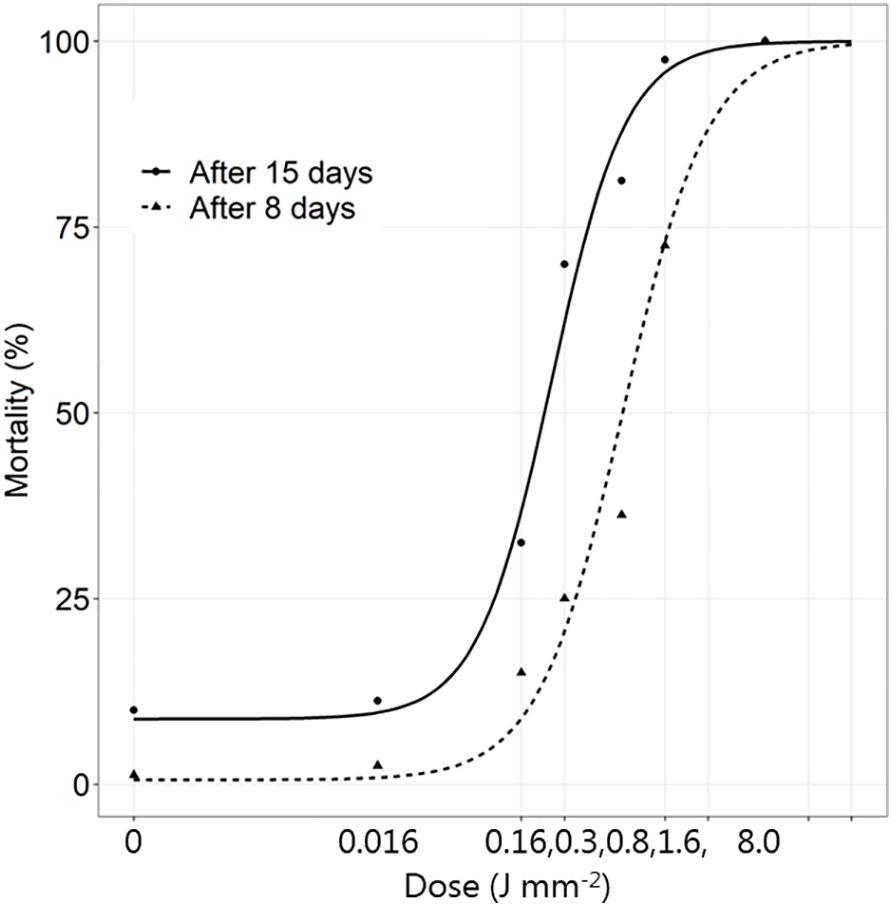
Figure 4 The mortality (%) of Tenebrio molitor pupae 8 and 15 days after exposure to increasing dosages of laser energy (J m-2) from a thulium-doped 2 µm 50 W fiber laser with a collimated beam (Ø = 2 mm). Points show mean values (n=20).
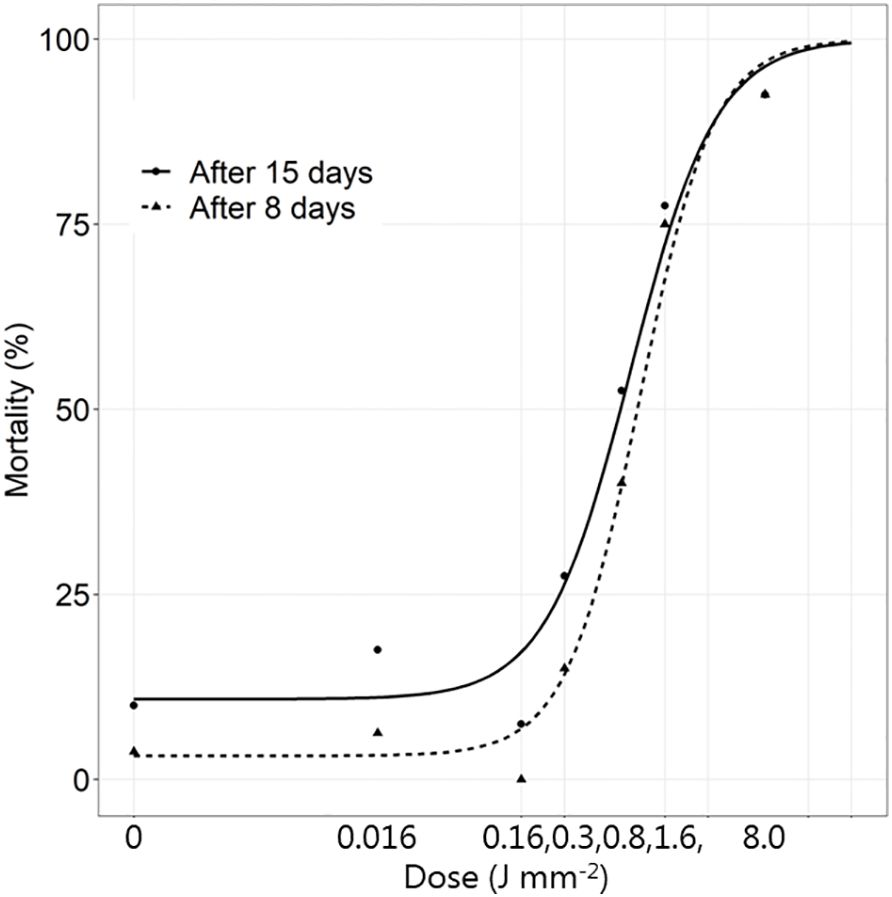
Figure 6 The mortality (%) of Tenebrio molitor beetles 8 and 15 days after exposure to increasing dosages of laser energy (J) from a thulium-doped 2 μm 50 W fiber laser with a collimated beam (Ø = 2 mm). Points show mean values (n=20).
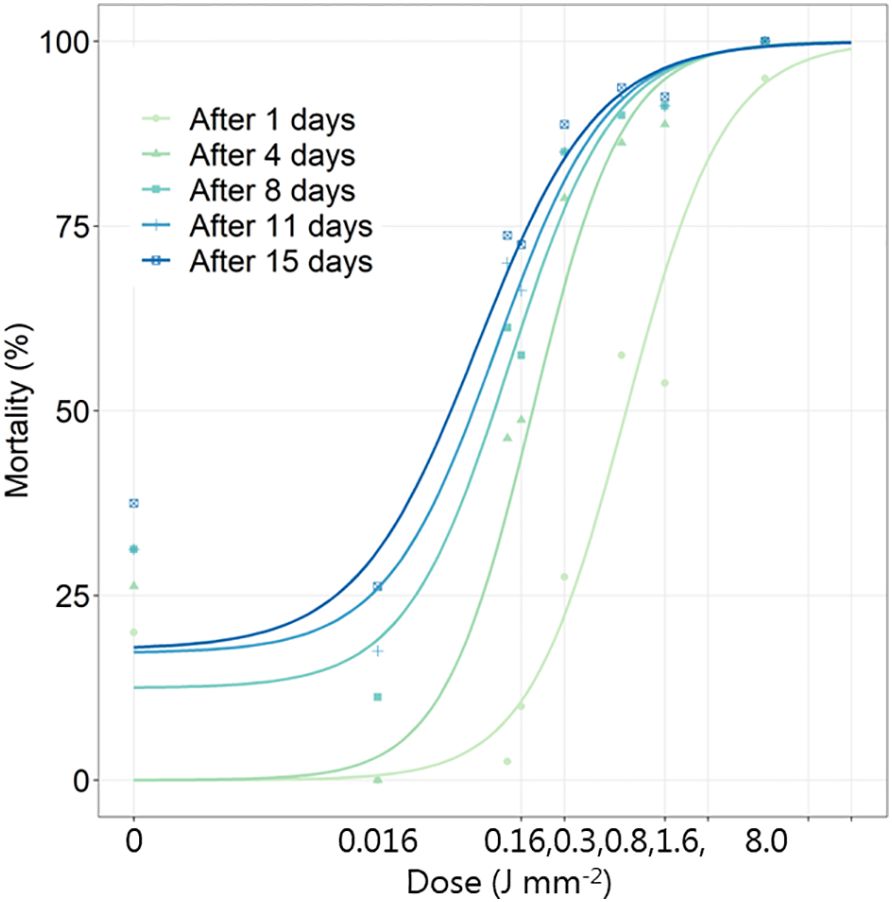
Figure 8 The mortality (%) of Adalia bipunctata beetles 1, 4, 8, 11 and 15 days after exposure to increasing dosages of laser energy (J) from a thulium-doped 2 μm 50 W fiber laser with a collimated beam (Ø = 2 mm). Points show mean values (n=20).
There was an error in the caption for Figure 3. The corrected caption appears below.
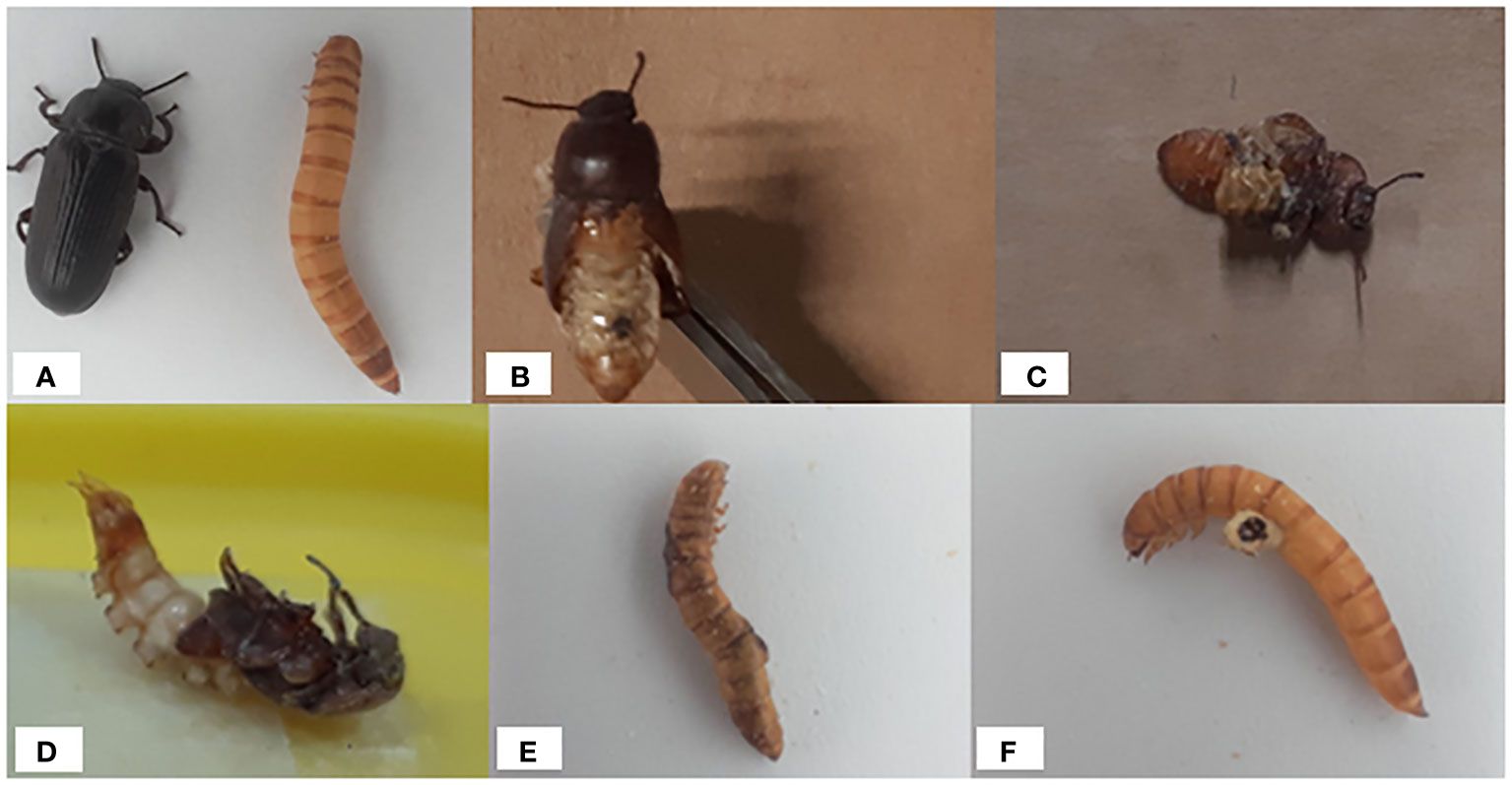
Figure 3 Deformities observed during the study of T. molitor (larvae experiment): (A) T. molitor control adult and larva. (B) 0.016 J m-2: Larva becomes a deformed alive adult. (C) 0.32 J m-2: Larva developed into a deformed adult and died. (D) 0.80 J m-2: Larva did not complete metamorphosis (severely deformed insect: half pupa, half adult). (E) 1.59 J m-2: Burned (brownish-dark) larva. (F) 7.95 J m-2: Larva were rapidly killed after exposure, and there was significant damage caused to the insects, e.g., hemolymph flowed out of the laser hole in the insects’ body.

Figure 5 Typical deformities that were observed on Tenebrio molitor after laser application (pupae experiment): (A) T. molitor control pupa. (B) 0.016 J m-2 (1 ms): Pupa developed into adult with deformed wings. (C) 0.16 J m-2: Non-living adult and adults broken into pieces. (D) 0.32 J m-2: Pupa transformed to an injured adult. (E) Pupa died few days after laser application having a brown-burned appearance.
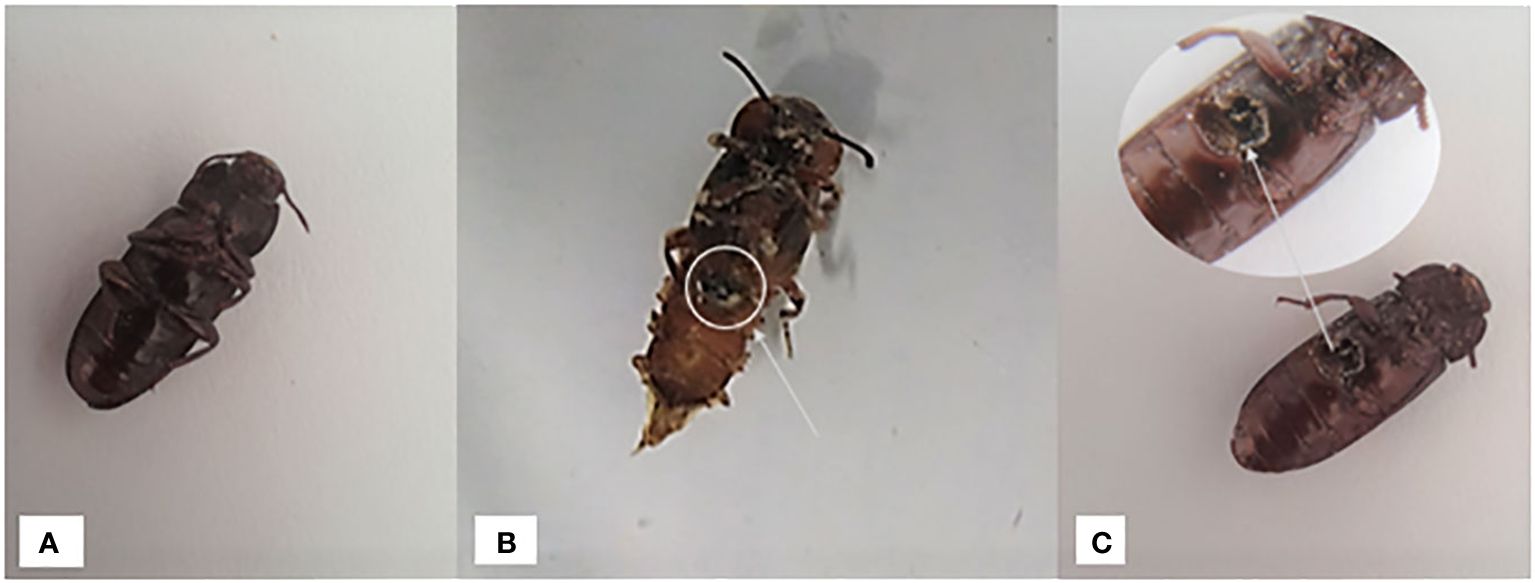
Figure 7 Typical deformities that were observed on Tenebrio molitor adults after laser application (adults’ experiment): (A) 0.016 J m-2: T. molitor adults were alive with normal appearance. (B) 0.32 J m-2: a living adult with a spot from the laser. (C) 7.95 J m-2: T. molitor adult died immediately with a large hole in its body.
Figure 3 Deformities observed during the study of T. molitor (larvae experiment): (A) T. molitor control adult and larva. (B) 0.016 J m-2: Larva becomes a deformed alive adult. (C) 0.32 J m-2: Larva developed into a deformed adult and died. (D) 0.80 J m-2: Larva did not complete metamorphosis (severely deformed insect: half pupa, half adult). (E) 1.59 J m-2: Burned (brownish-dark) larva. (F) 7.95 J m-2: Larva were rapidly killed after exposure, and there was significant damage caused to the insects, e.g., hemolymph flowed out of the laser hole in the insects’ body.
There was an error in the caption for Figure 5. The corrected caption appears below.
Figure 5 Typical deformities that were observed on Tenebrio molitor after laser application (pupae experiment): (A) T. molitor control pupa. (B) 0.016 J m-2 (1 ms): Pupa developed into adult with deformed wings. (C) 0.16 J m-2: Non-living adult and adults broken into pieces. (D) 0.32 J m-2: Pupa transformed to an injured adult. (E) Pupa died few days after laser application having a brown-burned appearance.
There was an error in the caption for Figure 7. The corrected caption appears below.
Figure 7 Typical deformities that were observed on Tenebrio molitor adults after laser application (adults’ experiment): (A) 0.016 J m-2: T. molitor adults were alive with normal appearance. (B) 0.32 J m‐2: a living adult with a spot from the laser. (C) 7.95 J m‐2: T. molitor adult died immediately with a large hole in its body.
There was also an error in Supplementary Table 1. The dosages mentioned were not correct. This material updated in the original article.
The authors apologize for these errors and state that they do not change the scientific conclusions of the article in any way. The original article has been updated.
Publisher’s note
All claims expressed in this article are solely those of the authors and do not necessarily represent those of their affiliated organizations, or those of the publisher, the editors and the reviewers. Any product that may be evaluated in this article, or claim that may be made by its manufacturer, is not guaranteed or endorsed by the publisher.
Keywords: integrated weed management, laser non-target, laser eco-toxicology, non-chemical weed control, site-specific weed management, thermal weed control
Citation: Andreasen C, Vlassi E, Johannsen KS and Jensen SM (2024) Corrigendum: Side-effects of laser weeding: quantifying off-target risks to earthworms (Enchytraeids) and insects (Tenebrio molitor and Adalia bipunctata). Front. Agron. 6:1376450. doi: 10.3389/fagro.2024.1376450
Received: 25 January 2024; Accepted: 27 March 2024;
Published: 11 April 2024.
Edited and Reviewed by:
Rick Llewellyn, Commonwealth Scientific and Industrial Research Organisation (CSIRO), AustraliaCopyright © 2024 Andreasen, Vlassi, Johannsen and Jensen. This is an open-access article distributed under the terms of the Creative Commons Attribution License (CC BY). The use, distribution or reproduction in other forums is permitted, provided the original author(s) and the copyright owner(s) are credited and that the original publication in this journal is cited, in accordance with accepted academic practice. No use, distribution or reproduction is permitted which does not comply with these terms.
*Correspondence: Christian Andreasen, Y2FuQHBsZW4ua3UuZGs=
 Christian Andreasen
Christian Andreasen Eleni Vlassi
Eleni Vlassi Kenneth S. Johannsen
Kenneth S. Johannsen Signe M. Jensen
Signe M. Jensen